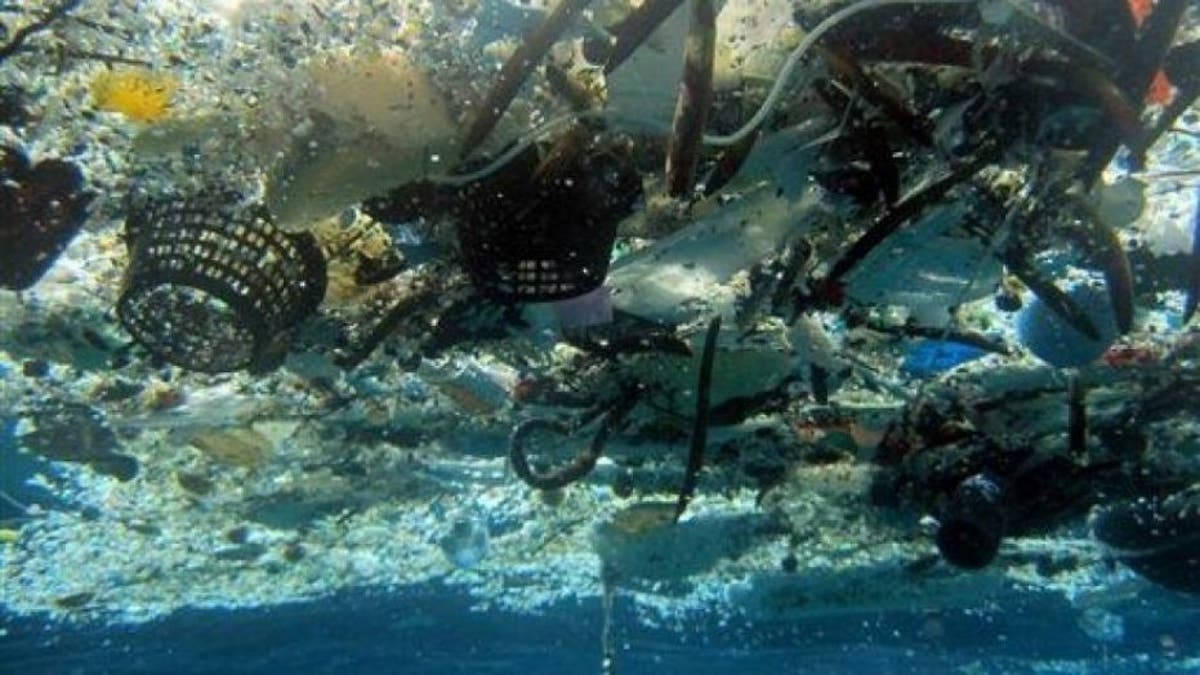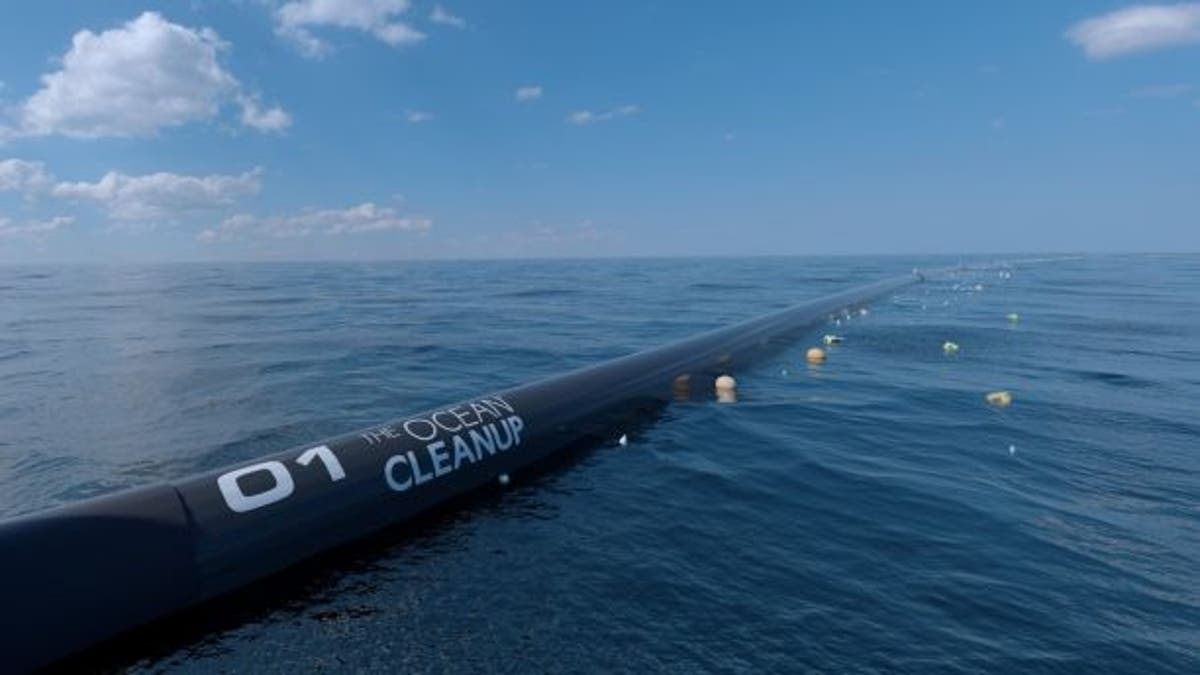
The Ocean Cleanup is deploying a vessel made up of several pipes between California and Hawaii to trap garbage at the surface. (The Ocean Cleanup)
Officials are gearing up for the launch of a floating vessel — an elaborate plan masterminded by a college dropout — this weekend with the hope it will act as a giant trash collector and eventually rid the Pacific Ocean of a Texas-sized "island" of garbage.
The Ocean Cleanup Foundation plans to release the 2,000-foot-long, U-shaped contraption from San Francisco on Saturday. It will be towed through the bay, underneath the Golden Gate Bridge and taken hundreds of miles offshore, where it will undergo final testing.
After several trials, which are expected to take at least two weeks, the vessel will head toward the chunk of garbage that now stretches 600,000 square miles between California and Hawaii.
Dutch inventor Boyan Slat, the 24-year-old CEO of The Ocean Cleanup, is spearheading the multi-million dollar project.
PLAN TO CLEAR GREAT PACIFIC GARBAGE PATCH, TEXAS-SIZED 'ISLAND' OF TRASH IN OCEAN, DRAWS CONCERNS
"After 273 scale model tests, six at-sea prototypes, a comprehensive mapping of the Great Pacific Garbage Patch (GPGP) with 30 vessels and an airplane, and several technology iterations, we are now ready to put the world’s first ocean cleanup system to the test," The Ocean Cleanup said in a statement provided to Fox News.
The vessel will float on top of the water, using a screen attached below to collect plastic and other debris. The floating barrier will then concentrate the plastic garbage at a central point where it can be fished out of the water and shipped back to dry land for recycling.
If everything goes according to plan and the device is a success, The Ocean Cleanup estimates they will be able to bring back their first batch of plastic to San Francico within months of the launch.
"During the period where System 001 is the only active cleanup system, we project 50 tons of plastic to be extracted per year. The full fleet of systems is projected to extract up to 14,000 tons of plastic per year. We estimate to be able to remove 50 percent of the plastic circulating in the Great Pacific Garbage Patch every 5 years, once we have reached full scale deployment of 60 systems," the organization says.
While the project sounds promising, some experts have expressed concern about the impact it could have on marine life — as well as the message it's sending.
Eben Schwartz, marine debris program manager for the California Coastal Commission, previously told Fox News he believes the organization has the "best intentions" but they're only tackling a small percentage of overall plastic entering the oceans each year.
GREAT PACIFIC GARBAGE PATCH, FLOATING 'ISLAND' OF TRASH IN OCEAN, IS NOW TWICE THE SIZE OF TEXAS
"Eight million metric tons [of trash] are entering the world's oceans every single year," Schwartz said. "Their project could be wildly successful cleaning the surface, but they're only tackling a minuscule percentage."
Schwartz, who has met with members of The Ocean Cleanup and toured their test facility, clarified that he hopes the project is a "huge success." However, he has concerns with some of the group's rhetoric.
"My biggest concern isn't the project itself, it's the messaging that's coming out," Schwartz explained. "They're cleaning only what's on the surface. We see plastic throughout water columns, on the ocean floor, deposited in polar ice caps. The problem is much, much much larger than the messaging suggests."

A "floating" island of trash dubbed the Great Pacific Garbage Patch (GPGP) now stretches 600,000 square miles. (AP Photo/NOAA Pacific Islands Fisheries Science Center)
However, The Ocean Cleanup says it has never condoned the message that it's "OK" to litter, adding that they don't believe their method is the only solution to the problem either.
"While cleaning up persistent floating ocean plastic is only one part of the equation, it is the only solution to an existing problem. Even if we stop all plastic from entering the oceans, we have to face the fact there are huge amounts of plastic in the ocean that needs to be cleaned up before it breaks down into smaller parts," the organization told Fox News in August.
The Ocean Cleanup claims it has not diminished the problem of pollution plaguing our oceans — and adds it simply wants to tackle the issue before things get worse.
Schwartz also voiced concerns about the impact the contraption will have on marine life. The cleanup vessel, which is made up of a set of connected pipes, will hang a 9-foot-long net below it to trap garbage.

The Ocean Cleanup performed hundreds of scale model tests over the years to ensure the vessel would be able to handle rough currents. (The Ocean Cleanup)
"The way the ocean works I think it would be near impossible for there to be zero impacts to marine wildlife from this device trapping everything at the surface," Schwartz explained. "It'll be trapping krill, plankton ... which makes it a potential feeding ground for animals."
Ocean Cleanup, however, defended its model and pointed to several systems they've put in place to protect marine life.
The vessel's slow speed, impenetrable screen and people checking for signs of marine life as the screen is lifted from the water will help avoid any casualties, Ocean Cleanup states.
"We will monitor the system and its surroundings continuously with the help of both human observers as well as equipment on and around the system. We will be using PAM, cameras on the system, acoustic buoys and the AutoNautTM, an autonomous, remotely-operated surveillance vessel," the group recently noted.
